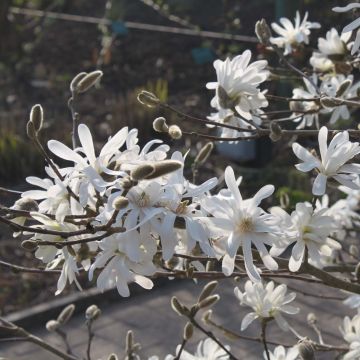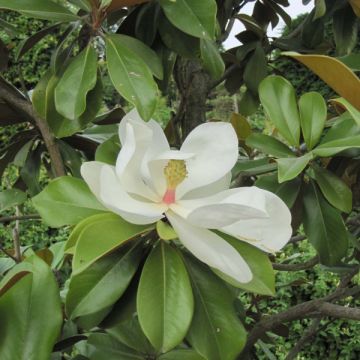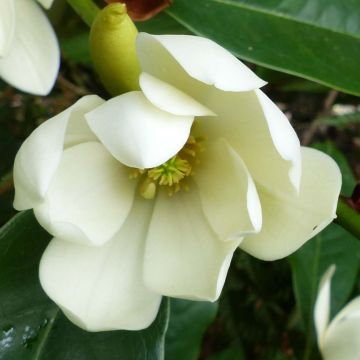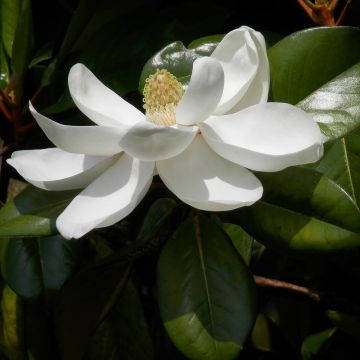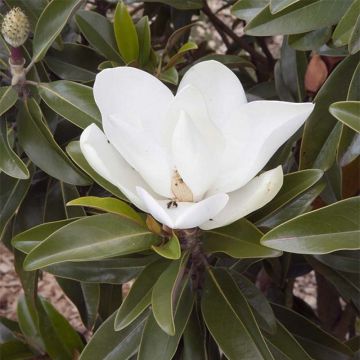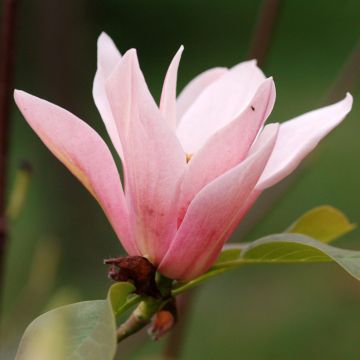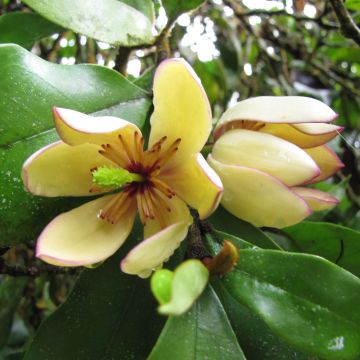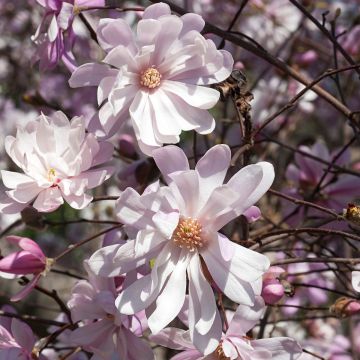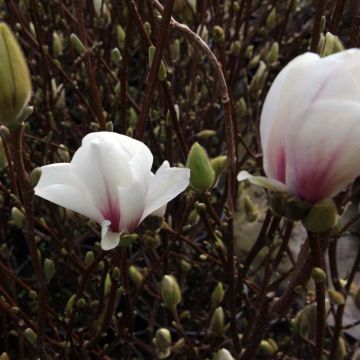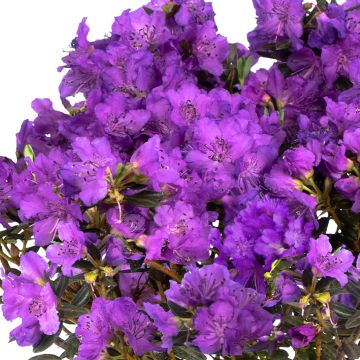

Magnolia grandiflora Purpan


Magnolia grandiflora Purpan
Magnolia grandiflora Purpan
Magnolia grandiflora Purpan
Summer Magnolia, Large-flowered Magnolia, Bull bay Magnolia, Evergreen Magnolia
Although the package arrived quite battered, the plants inside were very well protected, in excellent condition and larger than I thought they would be. You have a great selection, and I will definitely buy from you again. Have a nice day!
Zoran, 05/11/2024
Why not try an alternative variety in stock?
View all →This plant carries a 24 months recovery warranty
More information
We guarantee the quality of our plants for a full growing cycle, and will replace at our expense any plant that fails to recover under normal climatic and planting conditions.
Oversize package: home delivery by special carrier from €6.90 per order..
Express home delivery from €8.90.
Delivery to Corse prohibited: UE law prohibits the import of this plant from mainland France to Corse as part of the fight against Xylella fastidiosa. Please accept our sincere apologies.
More information

Does this plant fit my garden?
Set up your Plantfit profile →
Description
Magnolia grandiflora 'Purpan', derived from a unique subject considered one of the most remarkable specimens in Europe, is a highly desirable selection of the summer magnolia with large flowers. With a narrow and conical habit, this vigorous magnolia flowers, unlike the species type, well before its tenth anniversary, and abundantly. Adorned throughout the year with large, dark green and slightly undulate leaves, it offers sublime flowers in summer for almost three months, resembling large cream-white tulips, extremely fragrant.
Native to the Southeastern United States, Magnolia grandiflora, also known as Southern Magnolia, thrives in light, heat, humidity, and rich, deep soils. Its range extends from Texas to Virginia, passing through the northern and central parts of Florida.
'Purpan' comes from a unique subject, planted many years ago at the Purpan Agricultural School in Toulouse. It is characterized by its vigour, narrow and dense pyramidal habit, rapid flowering, and floriferousness. This tree will ultimately reach a height of about 13.50 m (44 ft) with a spread of 5 to 6 m (16.5 - 19 ft). Its growth is quite slow. Flowering mainly occurs in summer, from June to August-September (in the southeastern United States, flowering begins in late April and ends in July). The large solitary flowers, resembling tulips 15 to 25 cm (5.9 - 9.8 in) in diameter, are composed of thick petals, creamy white, open around a pink cone covered with yellow stamens. Each flower only lasts one day on the tree, but they are continuously renewed. The flowers are particularly fragrant. They are followed by the formation of large reddish cones, quite decorative, revealing red seeds. The evergreen leaves, arranged alternately on the branches, are simple, entire, thick, and leathery, measuring 15-20 cm (5.9 - 7.9 in) in length. They are dark green and glossy on the upper surface, rusty on the underside. In 'Purpan', they are slightly undulate.
Magnolia grandiflora 'Purpan' is primarily used as a solitary tree in a medium-sized garden, but also as a street tree alongside a larger property. Choose a strategic location in the garden to be able to admire this tree, perhaps the most beautiful of all evergreens, and thus enjoy its magnificent lemon-scented blooms. It could be associated, for example, with another large deciduous and spring-flowering variety, such as Magnolia soulangeana.
Report an error about the product description
Magnolia grandiflora Purpan in pictures


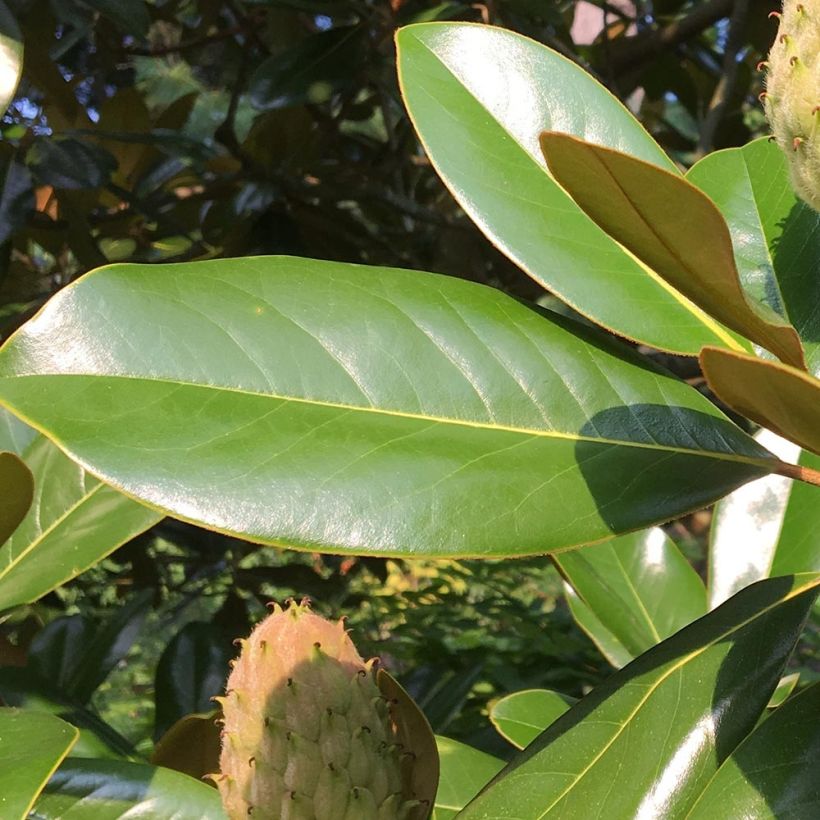



Plant habit
Flowering
Foliage
Botanical data
Magnolia
grandiflora
Purpan
Magnoliaceae
Summer Magnolia, Large-flowered Magnolia, Bull bay Magnolia, Evergreen Magnolia
Cultivar or hybrid
Other Magnolia
Planting and care
Magnolia grandiflora 'Purpan' is planted in spring in deep, rich, moist or even humid forest (pH around 6) soil in summer. Ericaceous soil is not recommended, as it is too poor. This magnolia will also be happy with a deep and rich soil that is very slightly limestone. Once well established and sufficiently developed, this large-flowered magnolia resists dry summers fairly well if in deep soil. It appreciates a sunny and open site but sheltered from the prevailing winds. At planting be careful not to break the fleshy roots and not to bury the root ball too deeply. Mulch and water in summer during the first years. Beware of strong frost. Maintain good humidity by showering its foliage with a fine mist, only in the evening, if the day has been hot. Pruning is unnecessary.
Planting period
Intended location
Care
-
, onOrder confirmed
Reply from on Promesse de fleurs
Evergreen shrubs
Haven't found what you were looking for?
Hardiness is the lowest winter temperature a plant can endure without suffering serious damage or even dying. However, hardiness is affected by location (a sheltered area, such as a patio), protection (winter cover) and soil type (hardiness is improved by well-drained soil).

Photo Sharing Terms & Conditions
In order to encourage gardeners to interact and share their experiences, Promesse de fleurs offers various media enabling content to be uploaded onto its Site - in particular via the ‘Photo sharing’ module.
The User agrees to refrain from:
- Posting any content that is illegal, prejudicial, insulting, racist, inciteful to hatred, revisionist, contrary to public decency, that infringes on privacy or on the privacy rights of third parties, in particular the publicity rights of persons and goods, intellectual property rights, or the right to privacy.
- Submitting content on behalf of a third party;
- Impersonate the identity of a third party and/or publish any personal information about a third party;
In general, the User undertakes to refrain from any unethical behaviour.
All Content (in particular text, comments, files, images, photos, videos, creative works, etc.), which may be subject to property or intellectual property rights, image or other private rights, shall remain the property of the User, subject to the limited rights granted by the terms of the licence granted by Promesse de fleurs as stated below. Users are at liberty to publish or not to publish such Content on the Site, notably via the ‘Photo Sharing’ facility, and accept that this Content shall be made public and freely accessible, notably on the Internet.
Users further acknowledge, undertake to have ,and guarantee that they hold all necessary rights and permissions to publish such material on the Site, in particular with regard to the legislation in force pertaining to any privacy, property, intellectual property, image, or contractual rights, or rights of any other nature. By publishing such Content on the Site, Users acknowledge accepting full liability as publishers of the Content within the meaning of the law, and grant Promesse de fleurs, free of charge, an inclusive, worldwide licence for the said Content for the entire duration of its publication, including all reproduction, representation, up/downloading, displaying, performing, transmission, and storage rights.
Users also grant permission for their name to be linked to the Content and accept that this link may not always be made available.
By engaging in posting material, Users consent to their Content becoming automatically accessible on the Internet, in particular on other sites and/or blogs and/or web pages of the Promesse de fleurs site, including in particular social pages and the Promesse de fleurs catalogue.
Users may secure the removal of entrusted content free of charge by issuing a simple request via our contact form.
The flowering period indicated on our website applies to countries and regions located in USDA zone 8 (France, the United Kingdom, Ireland, the Netherlands, etc.)
It will vary according to where you live:
- In zones 9 to 10 (Italy, Spain, Greece, etc.), flowering will occur about 2 to 4 weeks earlier.
- In zones 6 to 7 (Germany, Poland, Slovenia, and lower mountainous regions), flowering will be delayed by 2 to 3 weeks.
- In zone 5 (Central Europe, Scandinavia), blooming will be delayed by 3 to 5 weeks.
In temperate climates, pruning of spring-flowering shrubs (forsythia, spireas, etc.) should be done just after flowering.
Pruning of summer-flowering shrubs (Indian Lilac, Perovskia, etc.) can be done in winter or spring.
In cold regions as well as with frost-sensitive plants, avoid pruning too early when severe frosts may still occur.
The planting period indicated on our website applies to countries and regions located in USDA zone 8 (France, United Kingdom, Ireland, Netherlands).
It will vary according to where you live:
- In Mediterranean zones (Marseille, Madrid, Milan, etc.), autumn and winter are the best planting periods.
- In continental zones (Strasbourg, Munich, Vienna, etc.), delay planting by 2 to 3 weeks in spring and bring it forward by 2 to 4 weeks in autumn.
- In mountainous regions (the Alps, Pyrenees, Carpathians, etc.), it is best to plant in late spring (May-June) or late summer (August-September).
The harvesting period indicated on our website applies to countries and regions in USDA zone 8 (France, England, Ireland, the Netherlands).
In colder areas (Scandinavia, Poland, Austria...) fruit and vegetable harvests are likely to be delayed by 3-4 weeks.
In warmer areas (Italy, Spain, Greece, etc.), harvesting will probably take place earlier, depending on weather conditions.
The sowing periods indicated on our website apply to countries and regions within USDA Zone 8 (France, UK, Ireland, Netherlands).
In colder areas (Scandinavia, Poland, Austria...), delay any outdoor sowing by 3-4 weeks, or sow under glass.
In warmer climes (Italy, Spain, Greece, etc.), bring outdoor sowing forward by a few weeks.



































